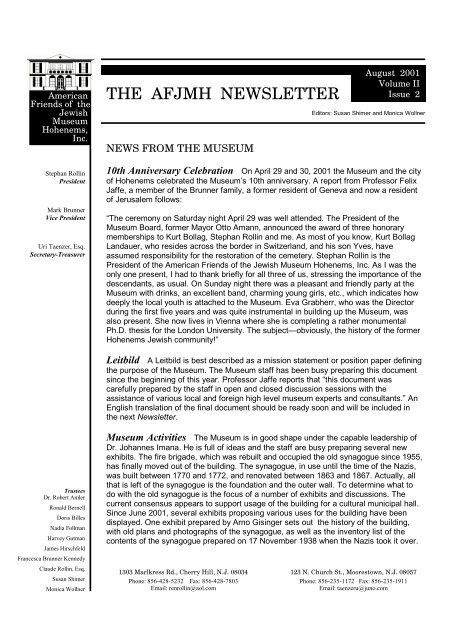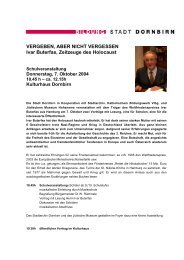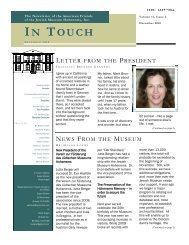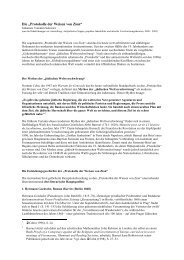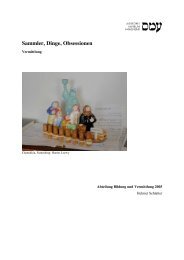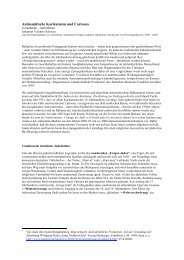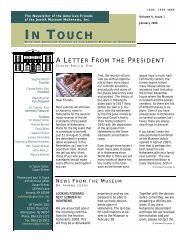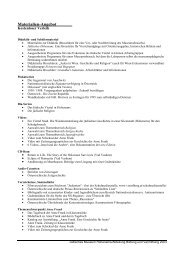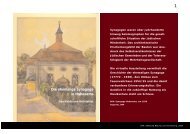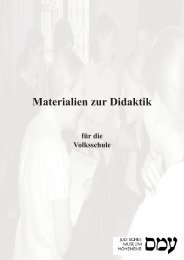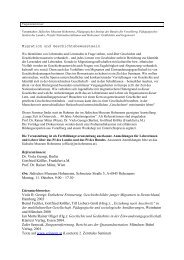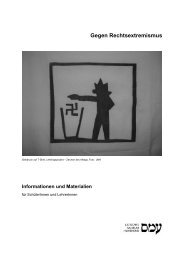THE AFJMH NEWSLETTER - Jüdisches Museum Hohenems
THE AFJMH NEWSLETTER - Jüdisches Museum Hohenems
THE AFJMH NEWSLETTER - Jüdisches Museum Hohenems
Create successful ePaper yourself
Turn your PDF publications into a flip-book with our unique Google optimized e-Paper software.
American.<br />
Friends of. the<br />
Jewish.<br />
<strong>Museum</strong>.<br />
<strong>Hohenems</strong>,.<br />
Inc..<br />
Stephan Rollin<br />
President<br />
Mark Brunner<br />
Vice President<br />
Uri Taenzer, Esq.<br />
Secretary-Treasurer<br />
Trustees<br />
Dr. Robert Amler<br />
Ronald Bernell<br />
Doris Billes<br />
Nadia Follman<br />
Harvey Gutman<br />
James Hirschfeld<br />
Francesca Brunner Kennedy<br />
Claude Rollin, Esq.<br />
Susan Shimer<br />
Monica Wollner<br />
<strong>THE</strong> <strong>AFJMH</strong> <strong>NEWSLETTER</strong><br />
NEWS FROM <strong>THE</strong> MUSEUM<br />
10th Anniversary Celebration On April 29 and 30, 2001 the <strong>Museum</strong> and the city<br />
of <strong>Hohenems</strong> celebrated the <strong>Museum</strong>’s 10th anniversary. A report from Professor Felix<br />
Jaffe, a member of the Brunner family, a former resident of Geneva and now a resident<br />
of Jerusalem follows:<br />
“The ceremony on Saturday night April 29 was well attended. The President of the<br />
<strong>Museum</strong> Board, former Mayor Otto Amann, announced the award of three honorary<br />
memberships to Kurt Bollag, Stephan Rollin and me. As most of you know, Kurt Bollag<br />
Landauer, who resides across the border in Switzerland, and his son Yves, have<br />
assumed responsibility for the restoration of the cemetery. Stephan Rollin is the<br />
President of the American Friends of the Jewish <strong>Museum</strong> <strong>Hohenems</strong>, Inc. As I was the<br />
only one present, I had to thank briefly for all three of us, stressing the importance of the<br />
descendants, as usual. On Sunday night there was a pleasant and friendly party at the<br />
<strong>Museum</strong> with drinks, an excellent band, charming young girls, etc., which indicates how<br />
deeply the local youth is attached to the <strong>Museum</strong>. Eva Grabherr, who was the Director<br />
during the first five years and was quite instrumental in building up the <strong>Museum</strong>, was<br />
also present. She now lives in Vienna where she is completing a rather monumental<br />
Ph.D. thesis for the London University. The subject—obviously, the history of the former<br />
<strong>Hohenems</strong> Jewish community!”<br />
Leitbild A Leitbild is best described as a mission statement or position paper defining<br />
the purpose of the <strong>Museum</strong>. The <strong>Museum</strong> staff has been busy preparing this document<br />
since the beginning of this year. Professor Jaffe reports that “this document was<br />
carefully prepared by the staff in open and closed discussion sessions with the<br />
assistance of various local and foreign high level museum experts and consultants.” An<br />
English translation of the final document should be ready soon and will be included in<br />
the next Newsletter.<br />
<strong>Museum</strong> Activities The <strong>Museum</strong> is in good shape under the capable leadership of<br />
Dr. Johannes Imana. He is full of ideas and the staff are busy preparing several new<br />
exhibits. The fire brigade, which was rebuilt and occupied the old synagogue since 1955,<br />
has finally moved out of the building. The synagogue, in use until the time of the Nazis,<br />
was built between 1770 and 1772, and renovated between 1863 and 1867. Actually, all<br />
that is left of the synagogue is the foundation and the outer wall. To determine what to<br />
do with the old synagogue is the focus of a number of exhibits and discussions. The<br />
current consensus appears to support usage of the building for a cultural municipal hall.<br />
Since June 2001, several exhibits proposing various uses for the building have been<br />
displayed. One exhibit prepared by Arno Gisinger sets out the history of the building,<br />
with old plans and photographs of the synagogue, as well as the inventory list of the<br />
contents of the synagogue prepared on 17 November 1938 when the Nazis took it over.<br />
1303 Marlkress Rd., Cherry Hill, N.J. 08034<br />
Phone: 856-428-5232 Fax: 856-428-7803<br />
Email: renrollin@aol.com<br />
August 2001<br />
Volume II<br />
Issue 2<br />
Editors: Susan Shimer and Monica Wollner<br />
123 N. Church St., Moorestown, N.J. 08057<br />
Phone: 856-235-1172 Fax: 856-235-1911<br />
Email: taenzeru@juno.com
During this month of August, the <strong>Museum</strong> has displayed films that give a glimpse into Jewish life. This is<br />
followed by a video installation by the Israel artist Naomi Tereza Salmon. Other exhibits will continue this year<br />
and next year.<br />
The exhibition on the Rosenthal Family, previously scheduled to open in October will now be held from June<br />
13, 2002 to September 30, 2002.<br />
The <strong>Museum</strong>’s hours of operation are Tuesday, to Sunday and holidays, 10 A.M. to 5 P.M. Talks and<br />
discussions relating to <strong>Hohenems</strong> and the Jewish community have continued through the year. For example<br />
on March 27, the museum held a talk in its café about the role of women in Jewish tradition, with examples<br />
from the Jewish community in <strong>Hohenems</strong>. Another discussion on May 3 told the story of the Landauers, a<br />
Jewish family of <strong>Hohenems</strong>.<br />
Of course, the <strong>Museum</strong> itself continues to display exhibits, which document the story of the <strong>Hohenems</strong>er<br />
Jews, and their religious, and daily lives. The <strong>Museum</strong>’s extensive library may be viewed during regular<br />
museum hours. The computer databank and archives may be accessed upon request. The archives contain<br />
original documents, as well as copies of the story of the Jewish community of <strong>Hohenems</strong>, and the history of<br />
Vorarlberg, the canton in which <strong>Hohenems</strong> is located.<br />
Convenient Payment Option Added! Dr. Imana has informed us that, by popular request, the<br />
<strong>Museum</strong>’s Verein now accepts payment of dues with the following credit cards: American Express, Visa,<br />
Master Card, and Diners Club. (Issuer, cardholder’s name, number and expiration date will do it!).<br />
<strong>THE</strong> CEMETERY<br />
The cemetery is under the auspices of the Society for the Preservation of the Jewish Cemetery <strong>Hohenems</strong>,<br />
and not the Jewish <strong>Museum</strong> <strong>Hohenems</strong>. Nevertheless, the American Friends has found great interest among<br />
our membership in supporting the improvement of the cemetery. While some members have chosen to make<br />
individual contributions in support of the cemetery, and the Brunner family has paid to have the Brunner<br />
graves restored, the American Friends has also made a recent contribution of $2,000 towards the<br />
improvement of the cemetery. The Office of Monument Protection is also restoring some graves. We<br />
anticipate that with these efforts, the entire cemetery should be in excellent shape in a few years.<br />
Kurt Bollag who directs the Society for the Preservation of the Jewish Cemetery <strong>Hohenems</strong> has recently<br />
reported on the activities of the Society in the year 2000. His report has been translated through the good<br />
offices of Stephan Rollin:<br />
“Schools and outside visitors (about 200 a year) visit the cemetery regularly after first getting the<br />
key from the guard at the Otten Company. Local artisans have made some repairs in the prayer<br />
hall at no charge.<br />
In spring 2000, Dr. Jaffe told Mag. Mack of the Austrian Agency of Historical Monument<br />
Preservation that the Brunner descendants are willing to pay three-quarters of the renovation costs<br />
for the graves of their ancestors. This work was done in the shop of the stonemason, Dr. Pfanner<br />
in Scheffau/Allgaeu. The gravestones were then reset in fall 2000.<br />
At that time, a second meeting included Dr. Madrisch and the forester. It was determined that five<br />
beech trees had to be removed at a cost of approximately 100,000 AS. This expense will be<br />
divided equally among the county of Vorarlberg, the town of <strong>Hohenems</strong>, the Austrian Monument<br />
Preservation Agency, and our Society. Identical financing will repair additional graves from 2001<br />
through 2003.<br />
Potential burials have to be approved by the Chevra Kadisha of St. Gallen and Mr. Amman in<br />
<strong>Hohenems</strong>.”<br />
2
101 BRUNNERS ON <strong>THE</strong> DALMATIAN COAST<br />
by Mark Brunner<br />
Trieste has existed since Roman times. Those Romans knew how to pick beautiful places. There, on an<br />
expansive bay at the very end of the Adriatic Sea, at the beginning of the spectacular Dalmatian coast, they<br />
created a harbor and built their houses on a hill overlooking the bay. They crowned the hill with a temple that<br />
was converted, in Christian times, to a church devoted to "San Guisto" the patron saint of Trieste.<br />
Today, Trieste is still a beautiful city flowing smoothly over hills and valleys hemmed in on the north by the<br />
escarpment of the "Carso," after which the rock formation "Karst" is named. It is a port city of around 300,000<br />
population, which has seen better days and worse days, but despite its great physical attraction, has not yet<br />
been found by thundering herds of tourists. None of the usual tourist traps exist. T-shirts and caps can only be<br />
found in clothing stores! It is, amazingly, an Italian city on a coast that is still fully Italian.<br />
The Brunner family, at their last meeting in <strong>Hohenems</strong>, had decided to have its next gathering here in Trieste.<br />
And an excellent choice it was. The Brunners have had a continuing presence in Trieste since 1832 when<br />
Patriarch Heinrich Brunner and his eldest son Jakob decided to establish a new family business. It was then a<br />
newly established major port for the great Austro-Hungarian Empire that grew rapidly into a major industrial<br />
center. From a textile distribution business, the Brunners' interests grew with the burgeoning city to include<br />
banking, insurance, and many other major Trieste enterprises.<br />
The reunion started with a welcome, a quick summary of our history, projected slides of historic family pictures<br />
and a fine catered dinner on the roof terrace of the Revoltella <strong>Museum</strong>. The next day our busy schedule<br />
carried us to the Synagogue for speeches by two Rabbis and then to the lovely wooded Jewish Cemetery<br />
where our forebears are buried, some in a Brunner compound. The next stop was the Riseria, formerly a rice<br />
processing plant, used by the Nazis to imprison, torture and murder Italian partisans, Communists and Jews-a<br />
sad, gloomy and depressing place of a memorial to man's inhumanity to man.<br />
Well over a hundred of us had arrived. Our very capable organizers provided two huge tour buses to transport<br />
us. How the drivers maneuvered those monsters through the narrow streets and around sharp comers<br />
amazed us Americans. At lunch, we were bussed (in air-conditioned luxury, escaping the heat!) to a park-like<br />
restaurant way out in the country on the Carso near the Slovenian border. Here, as we marveled at the beauty<br />
of the countryside and enjoyed lunch, horses, donkeys, ducks, geese and chickens, studied us curiously from<br />
their compounds. They had never seen so many Brunners before!<br />
After lunch, on we went-on to the Miramar Castle prettily perched on a rock outcropping, jutting into the<br />
Adriatic. This exquisite castle was built by Maximillian, heir to the throne of Hapsburg, whose stay in Trieste<br />
was cut short when he was sent to rule over Mexico and was killed in the revolution that gave Mexico its<br />
independence. He never saw his pride and joy completed. The Brunners used its beauty to good purpose and<br />
had a group photo taken. Dinner was held on the terrace overlooking the great blue bay at the nearby Riviera<br />
Hotel. Here, despite the long day, we table hopped—chatting energetically as we reacquainted with familiar<br />
kin and met new relatives and snapped pictures, to the point of exhaustion. What exquisite fun!<br />
The next day we visited the old section of Trieste, the Serbian Orthodox and Greek Orthodox Christian<br />
churches and crested the San Giusto Hill to admire an ancient Catholic Church with its lovely Roman mosaics.<br />
Later in the morning, in the council chamber of the town hall we were welcomed by the Deputy Mayor. The<br />
Deputy Mayor recalled some of the history of Trieste, the important part Brunners had played in its economy,<br />
and the great tragedy of World War I when Trieste was part of Austria-Hungary but very close to Italy; when a<br />
large portion of the population was Italian; when families were rived with conflicting loyalties; when cousins<br />
fought on opposite sides of the front lines; when brother fought against brother. At that point one of our<br />
cousins raised her hand and reminded the Deputy Mayor that the Brunners were one of those families.<br />
Moreover, indeed one of the streets is named Via Guido Brunner, a great hero, who was posthumously<br />
awarded the Italian "Medaglia d'Oro.” I later found out a part of Guido's story, whose mother was from staunch<br />
Italian stock and whose father, Rodolfo Brunner, was a <strong>Hohenems</strong>er Austrian with unswerving loyalty to the<br />
Hapsburgs. Rodolfo wrote a letter to King Franz Josef apologizing for the shame of his son Guido fighting for<br />
3
Italy and offering to serve in the Austrian Army in his stead. His offer was not accepted because he was too<br />
old. I met that grand old man in 1955 when he was 98 years old and still mentally sharp. He couldn't figure out<br />
who my father was, but then when I mentioned my grandfather Lucian his face lit up and he exclaimed: "Oh<br />
that Lucian! What a naughty boy he was." I never knew my grandfather. He died 16 years before I was born.<br />
In the afternoon, we attended a lecture based on the diary of Fanny Bles Brunner, a Manchester woman who<br />
married Philip Brunner and moved to Trieste in 1894. Following the lecture we had some general discussions<br />
of various and sundry family matters to which our ubiquitous cousin Felix Jaffe contributed vociferously. Felix<br />
and Dorothy Winter gathered information to bring our immense family tree up to date. The meeting ended with<br />
a beautifully photographed and paced film of the 1998 <strong>Hohenems</strong> Gathering produced by Christian Seiler,<br />
dedicated to his grandfather Hans Brunner, and narrated by Christian in his smooth mellifluous voice.<br />
That evening, at dinner in the old Cafe Tomaseo, we came together for one last marvelous meeting of<br />
chatting, gossiping, exchanging addresses, snapping pictures and (most importantly) to honor and show our<br />
appreciation to our hosts, Lisetta Brunner Dalla Palma, Helen Brunner and Giancarlo Stavro Santarosa for<br />
their magnificent efforts of organizing this wonderful reunion. Their work, to bring all this together for such a<br />
huge crowd of people, was truly a magnificent accomplishment. Theirs will be a hard act to follow.<br />
The whole Trieste experience was a wonderful, touching experience for us and we are grateful to have been a<br />
part of it. We met so many interesting people. In retrospect, I have to believe that they were all on their best<br />
behavior because they were all-every one of them-very gracious, very friendly, very pleasant and full of fun. It<br />
was especially inspiring to see the different generations so enthusiastically involved in the program. The<br />
oldest was Regina Stavro, 89, who was surrounded and doted on by a crowd of her children, grandchildren<br />
and great grandchildren, just as she had been two years prior at <strong>Hohenems</strong>. When her daughter gave her<br />
usual pill to take, she groused: "They want me to live another 20 years!" With raised hand and fire in her eyes,<br />
she urged all to keep faith with "the family, the family, the family."<br />
Zarina and I stayed another week and we were unstintingly spoiled by the cousins who live in Trieste.<br />
Where and when will the next reunion be?<br />
FINAL NOTES<br />
We are so pleased that our (still growing) dues-paying membership now numbers 58! What’s more, we are<br />
thankful for the numerous letters and calls of encouragement we have received from many of you. We<br />
encourage you to continue to share with our editors, Susan Shimer (zsshimer@earthlink.net) and Monica<br />
Wollner, or Stephan Rollin or Uri Taenzer, your ideas for future newsletter articles.<br />
On that note, we are interested to hear your opinion as to what aspects of the <strong>Museum</strong>, the cemetery or other<br />
projects should receive our financial support. As you know, this year meaningful contributions have been<br />
given towards the upkeep of the cemetery and we have committed to pay for the German to English<br />
translation of Eva Grabherr’s doctoral dissertation. With that in mind, you can expect more on Eva’s<br />
fascinating new book in the next newsletter. Along with this issue, we are pleased to include an article on the<br />
Bernheimer Family authored by Julie and Marc Levin in collaboration with George Arnstein, Carol and Ron<br />
Bernell, Dorothy and Herbert Leviton, Anita Springer and Jim Lerner.<br />
On a final note, it is especially rewarding to hear that our past articles have stimulated many of you to seek out<br />
familial roots and, just as importantly, <strong>AFJMH</strong> membership has fostered new and lasting contacts among our<br />
members and friends. With that in mind, Felix Jaffe asked us to help in locating descendents of the<br />
BRENTANO family that was prominent among the <strong>Hohenems</strong> families. To date, Nina Levinson has been<br />
unsuccessful in her efforts to locate them. Felix believes the <strong>Hohenems</strong>er Brentanos owned the Brentano<br />
Book Stores, now operated by Barnes & Noble. Could this be true?<br />
4


